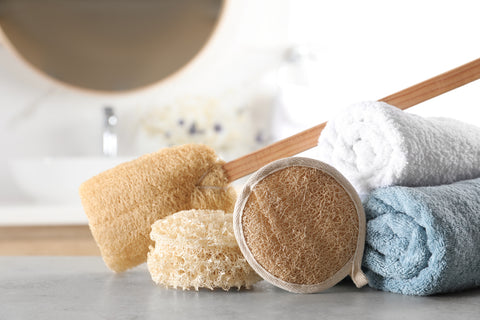I'm often asked how often teenagers should exfoliate their skin. The frequency depends on your individual skin type and concerns. Overdoing it can cause irritation and under-exfoliating can lead to clogged pores and acne.
This article aims to provide a detailed understanding of the process, its importance and best practices for young adults.

Exfoliation Defined
Essentially Exfoliation is the process of gently removing dead skin cells from the surface of your skin.
Why is Exfoliation Important for Teens?
During your teenage years, the skin tends to produce more oil due to hormonal changes, which can lead to clogged pores and breakouts.
Regular exfoliation helps in:
- Preventing and clearing clogged pores
- Reducing the appearance of acne scars
- Enhancing skin’s texture and brightness
- Allowing better absorption of skincare products

Types of Exfoliants
1 Mechanical / Physical Exfoliants -
In products, these contain micro-granules that facilitate the mechanical removal of dead skin cells and I would also include flannels, loofahs, sponges and brushes in this section.
2 Active Ingredient Containing Exfoliants -
Compounds, primarily alpha hydroxy acids (AHAs) like Lactic Acid or beta hydroxy acids (BHAs) like Salicylic Acid - aid in the breaking up of dead skin cells.
Recommended Frequency
1 Mechanical / Physical Exfoliants
Ideally, once weekly. Over-exfoliating with these exfoliants can cause microtears in your skin, leading to irritation and sensitivity. Take it easy.
2 Active Ingredient Exfoliants
Depending on concentration/strength, where you are using the products and skin type, 1 - 3 times a week is advised. Always read the products’ directions and use as instructed to get the best results.

Facial Exfoliation - A Careful Approach
The skin on your face is generally thinner and more sensitive than the rest of your body so it's important to approach exfoliation with care. Once a week on the face and back of the neck is recommended.
Exfoliation on other parts of the body

Body
Due to the slightly increased thickness of skin in these areas, a frequency of 2 - 3 times weekly is generally acceptable but don’t go mad. Focus on rough spots like knees, elbows and heels. Go gently on the back, chest and shoulders, especially if acne-prone. Remember to apply a moisturiser when you have dried off.
Lips
Owing to their delicate nature, once weekly with a mild exfoliant when required (such as in the winter months) is a good start.
What else should you know?
1. Understand your skin type
What works for your best friend might not work for you.
2. Always Moisturise
Moisturise after exfoliating to hydrate and protect your skin.
3. Sunscreen is essentail
Exfoliating can make your skin more sensitive to the sun.
4. Listen to your skin
If it feels tight, irritated or overly dry, you might be over-exfoliating.

Exfoliating Tips
- If you're new to exfoliating, start slowly. It's always easier to increase frequency gradually than to repair damaged skin.
- Rinse scrubs off thoroughly and moisturise after to avoid dryness.
- Reduce exfoliation if skin feels sensitive or irritated. Never scrub inflamed acne.
- See a dermatologist if breakouts persist after exfoliating. You may need medication.
- Hydrating masks can also gently slough off dead skin cells. Try a clay or sheet mask 1-2 times a week.
As young adults we experience considerable changes to our skin. An informed approach to skincare, particularly exfoliation, can achieve the best skin health. There are usually more questions than answers in skincare but remember that exfoliation is just one element to keeping your skin healthy.













